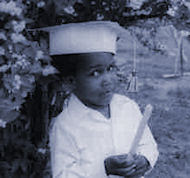The Wichita Eagle reports on the Wichita NAACP's Child Welfare efforts
Child services see racial gap
Reposted from: The Wichita Eagle
A quarter of the children admitted to the Wichita Children's Home so far this year have been African-American. That puzzles Sarah Robinson, the home's director.
The disparity exists among minority children -- and, in particular, black children -- at the children's home, in foster care, among children waiting for adoptions, and those who are arrested, in jail or involved in some way in the child welfare and juvenile justice systems, statistics show. "I do not understand why there is a disparity," Robinson said.
Neither does the Wichita branch NAACP, which has dedicated about five years engaging other child welfare agencies, advocates and state officials to examine the issue more closely.
Now, branch president Kevin Myles said he has been tapped to participate in a new subcabinet team backed by Gov. Kathleen Sebelius to study the disproportionate numbers of minority youths in the child welfare and juvenile justice systems. Officials haven't confirmed the work group's membership, yet, but expect to have membership finalized shortly after the new year, said Michelle Ponce, the department's director of communications.
Ponce said she expects the NAACP will play a role. The work group's goals include understanding causes of the disparity, identifying counties experiencing large racial inequalities, exploring poverty's role in juvenile issues and crafting solutions to recommend to the governor by fall 2009.
"Initially, our connection to it was just through complaints coming through the office," Myles said. "In investigating those complaints, what we found was just a very complex bureaucracy that parents have a very difficult time navigating. And if they're unsuccessful, it could cost them everything."
Finding solutions
Mary Dean, chair of the NAACP's legal redress committee, said there is a correlation between disparities in the child welfare system and the juvenile justice system.
"They were confused, angry, mad and upset," she said of children placed in the child welfare system whose families sought the NAACP's help. "When children are like that, they become juvenile offenders."
A 2008 SRS report found that although black children make up about 6 percent of the state's population, they accounted for 28 percent of youths in juvenile justice custody and nearly 22 percent of children in state child welfare custody at the end of June.
Patrick Woods, director of governmental affairs for the Kansas Department of Social and Rehabilitation Services, said the NAACP met occasionally with SRS officials for more than a year to discuss a broad range of issues including finding more resources for parents trying to reunite with their children. Woods credits the NAACP for keeping the conversation going among local child welfare agencies, such as Youthville.
Denise Hunter-Mitchell, director of foster care for Wichita and south-central Kansas for Youthville, said the agency is examining ways to encourage the state to ease some regulations to make placements among family members easier -- an area stakeholders identified as problematic and possibly adding to the disparities.
That's one potential solution, but others need to be identified to better determine why racial disparities linger, Dean said.
"For whatever reason," Dean said, "minority children are taken out (of their homes) quicker and kept longer than other children."
Looking for results
Sandra Gasca, chief program officer for Youthville, credits the NAACP for its dedication to finding answers.
"I think the efforts that the NAACP has made to continue to put this on the radar have been phenomenal," Gasca said. "I know there's other organizations, but (the NAACP) has really spearheaded this and worked very collaboratively with agencies like Youthville and others to try to address it."
Tanya Keys, director of children and family services for SRS, said the department's attempts to address the disparity have largely been at the community level and may not be "as visible to our stakeholders."
Keys said the juvenile justice system, on the other hand, has federal reporting requirements already aimed at reducing disparities.
Earlier this year, the results of a three-year pilot project backed by the federal government for communities to examine their juvenile justice practices -- from arrests through sentencing -- were released to county officials.
Sedgwick County reduced the number of minorities being admitted to juvenile correctional facilities and those being transferred to adult facilities, the report said.
But black youths were nearly four times more likely to be arrested and nearly three times more likely to be referred to a juvenile corrections facility compared with white youths, according to the report's findings.
Dean said she's pleased the research is there, but wants to see more action and better results.
"All we're doing is repeating the cycle that will never end unless we do something to really stop the madness," Dean said. "We're losing our children."
The disparity exists among minority children -- and, in particular, black children -- at the children's home, in foster care, among children waiting for adoptions, and those who are arrested, in jail or involved in some way in the child welfare and juvenile justice systems, statistics show. "I do not understand why there is a disparity," Robinson said.
Neither does the Wichita branch NAACP, which has dedicated about five years engaging other child welfare agencies, advocates and state officials to examine the issue more closely.
Now, branch president Kevin Myles said he has been tapped to participate in a new subcabinet team backed by Gov. Kathleen Sebelius to study the disproportionate numbers of minority youths in the child welfare and juvenile justice systems. Officials haven't confirmed the work group's membership, yet, but expect to have membership finalized shortly after the new year, said Michelle Ponce, the department's director of communications.
Ponce said she expects the NAACP will play a role. The work group's goals include understanding causes of the disparity, identifying counties experiencing large racial inequalities, exploring poverty's role in juvenile issues and crafting solutions to recommend to the governor by fall 2009.
"Initially, our connection to it was just through complaints coming through the office," Myles said. "In investigating those complaints, what we found was just a very complex bureaucracy that parents have a very difficult time navigating. And if they're unsuccessful, it could cost them everything."
Finding solutions
Mary Dean, chair of the NAACP's legal redress committee, said there is a correlation between disparities in the child welfare system and the juvenile justice system.
"They were confused, angry, mad and upset," she said of children placed in the child welfare system whose families sought the NAACP's help. "When children are like that, they become juvenile offenders."
A 2008 SRS report found that although black children make up about 6 percent of the state's population, they accounted for 28 percent of youths in juvenile justice custody and nearly 22 percent of children in state child welfare custody at the end of June.
Patrick Woods, director of governmental affairs for the Kansas Department of Social and Rehabilitation Services, said the NAACP met occasionally with SRS officials for more than a year to discuss a broad range of issues including finding more resources for parents trying to reunite with their children. Woods credits the NAACP for keeping the conversation going among local child welfare agencies, such as Youthville.
Denise Hunter-Mitchell, director of foster care for Wichita and south-central Kansas for Youthville, said the agency is examining ways to encourage the state to ease some regulations to make placements among family members easier -- an area stakeholders identified as problematic and possibly adding to the disparities.
That's one potential solution, but others need to be identified to better determine why racial disparities linger, Dean said.
"For whatever reason," Dean said, "minority children are taken out (of their homes) quicker and kept longer than other children."
Looking for results
Sandra Gasca, chief program officer for Youthville, credits the NAACP for its dedication to finding answers.
"I think the efforts that the NAACP has made to continue to put this on the radar have been phenomenal," Gasca said. "I know there's other organizations, but (the NAACP) has really spearheaded this and worked very collaboratively with agencies like Youthville and others to try to address it."
Tanya Keys, director of children and family services for SRS, said the department's attempts to address the disparity have largely been at the community level and may not be "as visible to our stakeholders."
Keys said the juvenile justice system, on the other hand, has federal reporting requirements already aimed at reducing disparities.
Earlier this year, the results of a three-year pilot project backed by the federal government for communities to examine their juvenile justice practices -- from arrests through sentencing -- were released to county officials.
Sedgwick County reduced the number of minorities being admitted to juvenile correctional facilities and those being transferred to adult facilities, the report said.
But black youths were nearly four times more likely to be arrested and nearly three times more likely to be referred to a juvenile corrections facility compared with white youths, according to the report's findings.
Dean said she's pleased the research is there, but wants to see more action and better results.
"All we're doing is repeating the cycle that will never end unless we do something to really stop the madness," Dean said. "We're losing our children."
~~~~~~











